Photos by Benjamin Williamson
Text by Ann Pollard Ranco
From our February 2023 issue
For thousands of years, my Penobscot ancestors have been coming to Mount Desert Island — a place we know as Pemetic, meaning “range of mountains” — to hunt, fish, clam, and forage and to celebrate the beauty and abundance of coastal living. We’ve been linked to this place since time immemorial, the creation of Pemetic rooted in our legends. While the recent centuries of European settlement on Mount Desert Island have interrupted many of our coastal lifeways, our connection to its lands and waters has remained steadfast.
When tourism to Acadia National Park began to pick up in the early 1900s, Wabanaki people sold handmade baskets along the roadside. When I was a child, my father and I spent a lot of time in Bar Harbor and shared a tradition of visiting Sand Beach during the winter. And we eagerly anticipated the annual Maine Indian Basketmakers Festival, in Bar Harbor, where we gathered to sing, dance, eat, carrying on our cultural traditions. During my university years, when I brought friends from away to visit the park, my heart filled with pride that my ancestors knew this place so well.
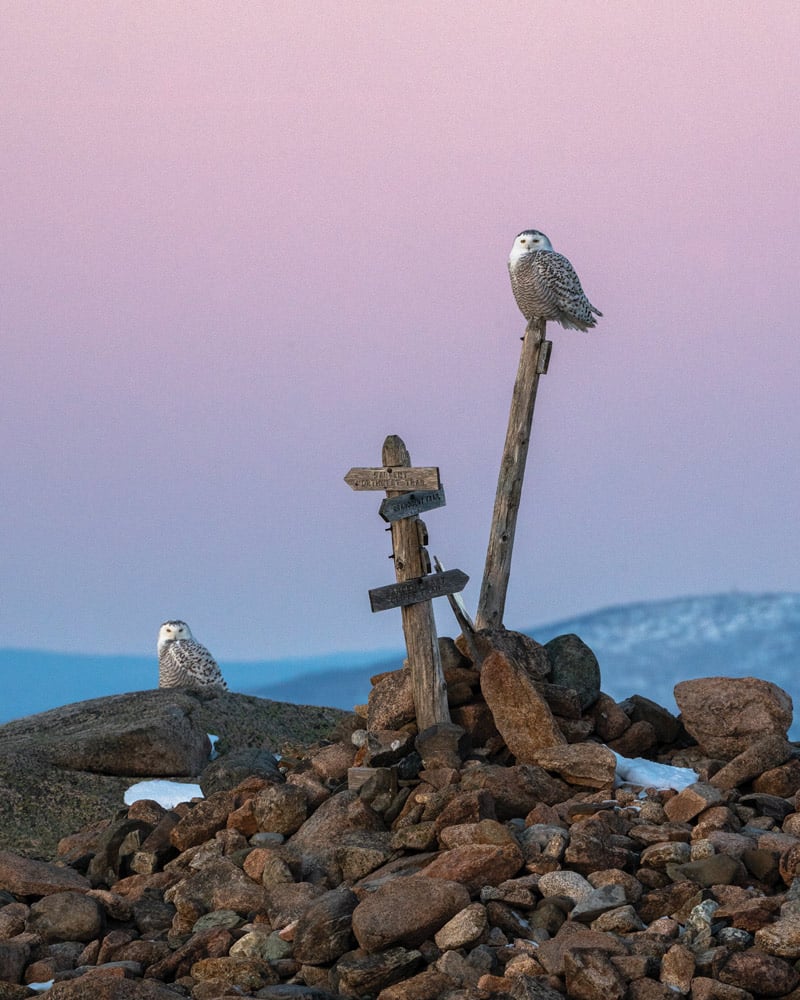

Left: Snowy owls on Sargent Mountain. The owls migrate from the Arctic in winter, and the alpine zone atop Acadia’s peaks makes for great rodent hunting. Right: The cliffside perch known as Raven’s Nest, on the park’s Schoodic Peninsula, across Frenchman Bay from MDI. Click to enlarge.
But it wasn’t until last winter that it dawned on me that I had never really had the chance to get to know Acadia on my own — and that there were many places on the island I’d never seen. Suddenly, I felt a strong urge to strengthen my relationship with this part of my ancestral homeland. So I spent the next few months devoting almost all of my free time to park adventures, driving to MDI week after week from my home in Orono and using friends’ seasonally closed Bar Harbor inn as a base camp. What I found was a rich and vivid land- and seascape, as fascinating as it was frigid, made all the more magical for the lack of visitors. Here are a few of my favorite experiences.

Sunrise Along Ocean Drive
A sharp wind cut through the morning air as I perched on a rock awaiting sunrise at Boulder Beach, one of the pocket beaches scattered along Acadia’s Ocean Drive. Bundled up in layer after layer, I was glad I’d also remembered to pack hand and toe warmers: the cold was no joke. Overlooking Otter Cliff, Boulder Beach faces east and basks in the morning light, its tumbled rocks encased in ice and reflecting the dawn. On this January morning, the extreme cold (a windchill of 14 below) created a phenomenon known as sea smoke, which forms when the air temperature is colder than the surface of the seawater. As the golden daylight filtered through it, those moments of bitter chill were worth it. Watching the gilded sea smoke dance atop the churning Atlantic was one of the most surreal experiences of my life.
This part of the Park Loop Road remains open year-round, and along the stretch between the park entrance station and Otter Cliff Road are several dramatic spots to admire a sunrise, including Sand Beach, Thunder Hole, Monument Cove, and Boulder Beach. These hibernal beachscapes, sculpted with ice features and rosy granite dusted in snow, are part of what make winter in Acadia truly extraordinary.


Skiing and Snowshoeing the Carriage Roads
In February, after one of the biggest snowfalls of the year, I hopped in the car and made a beeline for the carriage roads, a 45-mile network of wide trails, constructed of broken stone in the early 20th century. Because they were built to maximize scenery — with gentle-enough grades for horses — they’re perfect for skiing and snowshoeing. Portions of these roads are groomed by volunteers with Friends of Acadia, the park’s nonprofit conservation partner. I headed to what’s known as the Hadlock Loop, outside Northeast Harbor, where the trail is surrounded by evergreen trees bowing down in tiers of twinkling snow. Along with glimpses of the beautiful surrounding mountains, skiers on Hadlock Loop encounter three historic stone bridges: Hemlock, Waterfall, and Amphitheater. I spent all day admiring winter vignettes, until the late afternoon sunlight reminded me that daylight and tides are the island’s only timekeepers.
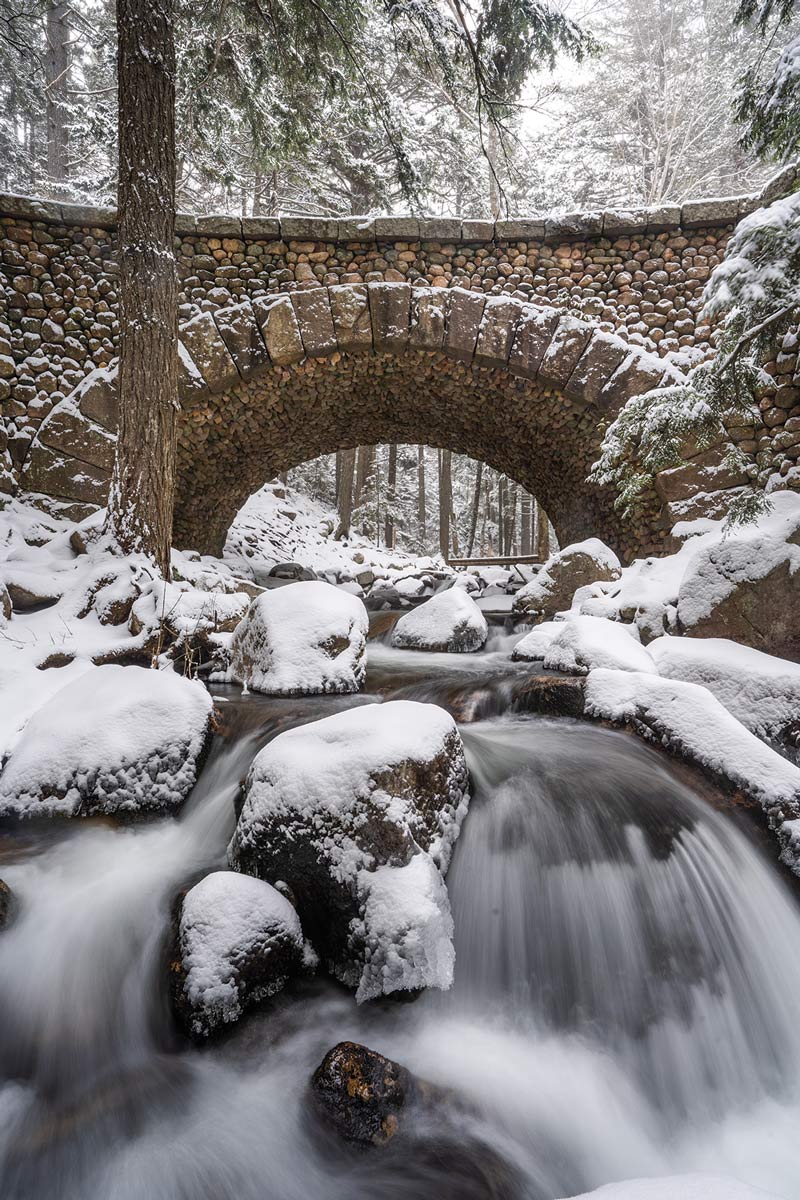

Two trailheads with parking areas access the four-mile Hadlock Loop: Brown Mountain parking area, on Route 3, across from Lower Hadlock Pond, and Parkman Mountain parking area, about a mile north. If those lots are full, there’s roadside parking at the Norumbega Mountain trailhead, between them, and a connector trail to the carriage roads. Walkers are also permitted on the groomed trails, but they should steer clear of the established ski tracks (and avoid leaving postholes in deep snow).
My other favorite winter carriage-road routes include the loops around Eagle Lake and Jordan Pond. The former is slightly longer, at six miles, with views of Cadillac and Pemetic mountains, among others, while the latter is just over three miles and offers the iconic view of the rounded twin peaks called the Bubbles.

Sunset on the Quiet Side
While Ocean Drive is the perfect spot for sunrise, the best views of sunset are found on the west side of the island, known as the “quiet side,” for its comparatively light summer traffic — although in winter, of course, it’s all quiet. Two of my favorite places to enjoy an Acadia sunset are from Bass Harbor Head Light, in Tremont, and along the nearby Ship Harbor Trail, in Southwest Harbor. Perched at MDI’s southernmost point, the 1858 Bass Harbor Head Light is one of Maine’s most often-photographed lighthouses, sitting on a pink-granite cliff and awash, in the evenings, in golden-hour light. If you’re up for a short hike, the gentle 1.3-mile trail at Ship Harbor leads through boreal forest and along exposed ledges overlooking the impressive swells of the open Atlantic. Find both along Route 102A, between Bass Harbor and Seawall Campground.
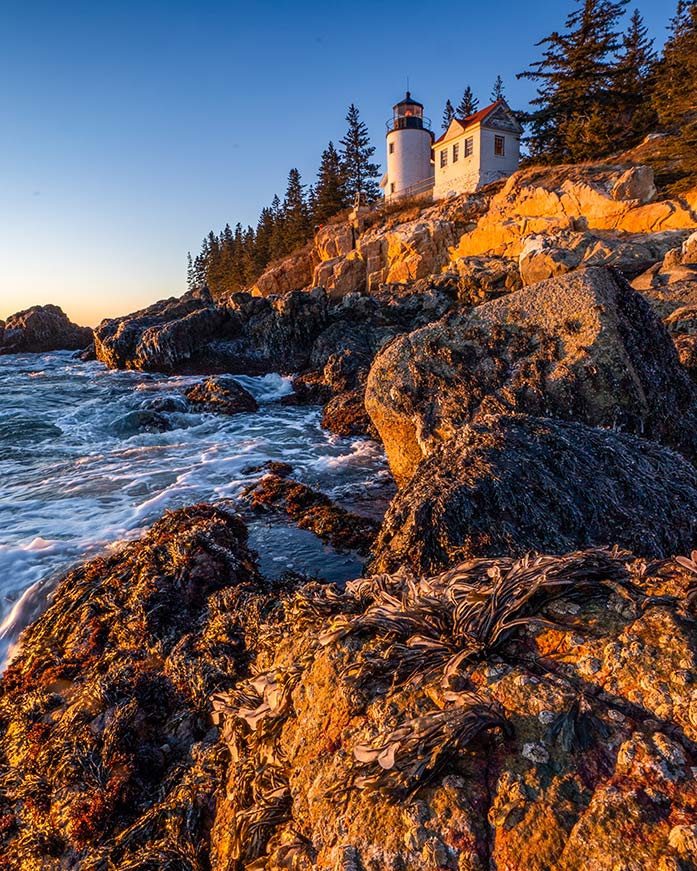

Know Before You Go
As I did most of my adventuring alone last winter, safety was top of mind. I never leave the car without packing some ice cleats in my bag, as portions of any Acadia trail can be very slippery. In addition to all of the winter wardrobe basics — a wicking base layer and waterproof outer layer, hat and gloves, decent boots — I find hand and toe warmers essential, as well as extra socks and gloves. Always pay attention to weather forecasts, particularly the wind speed and direction — nothing is colder than a winter windchill! — and prepare for changing conditions. The National Park Service recommends bringing a hard copy of a detailed trail map on any hike, as well as a headlamp or flashlight (not the one on your phone, as phone batteries drain quickly).
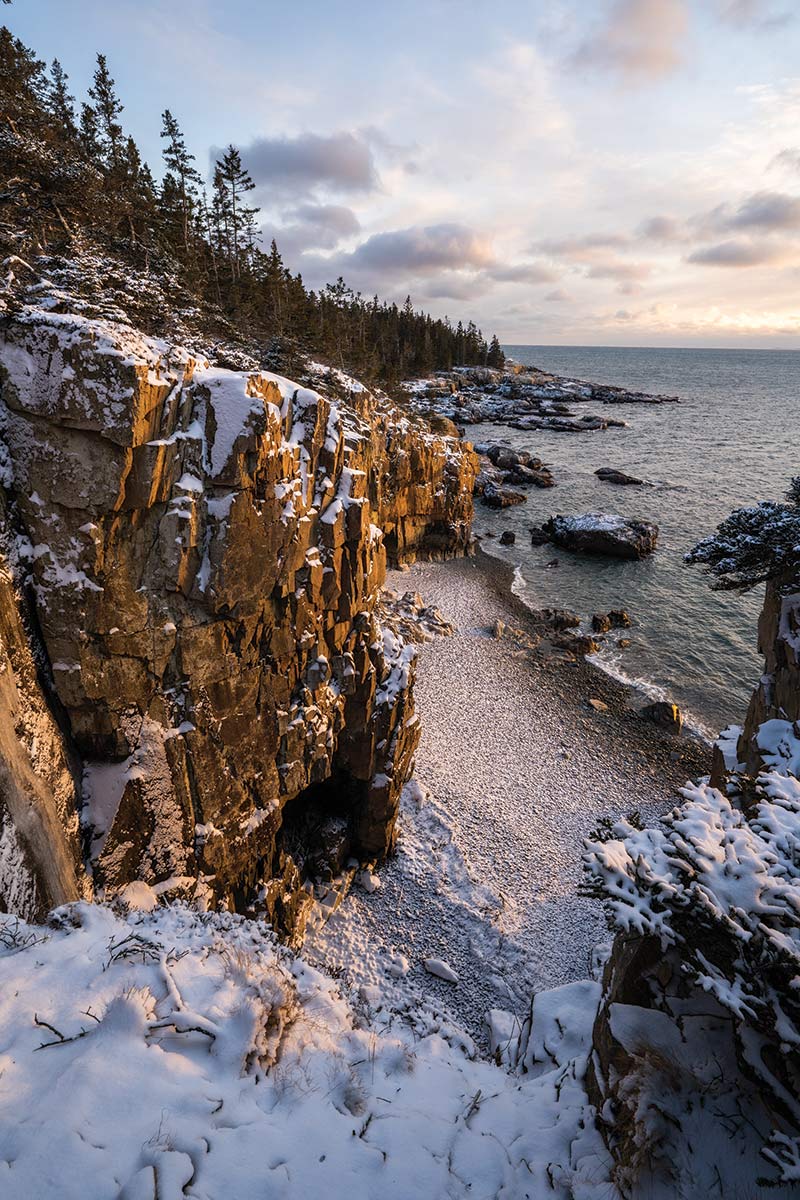
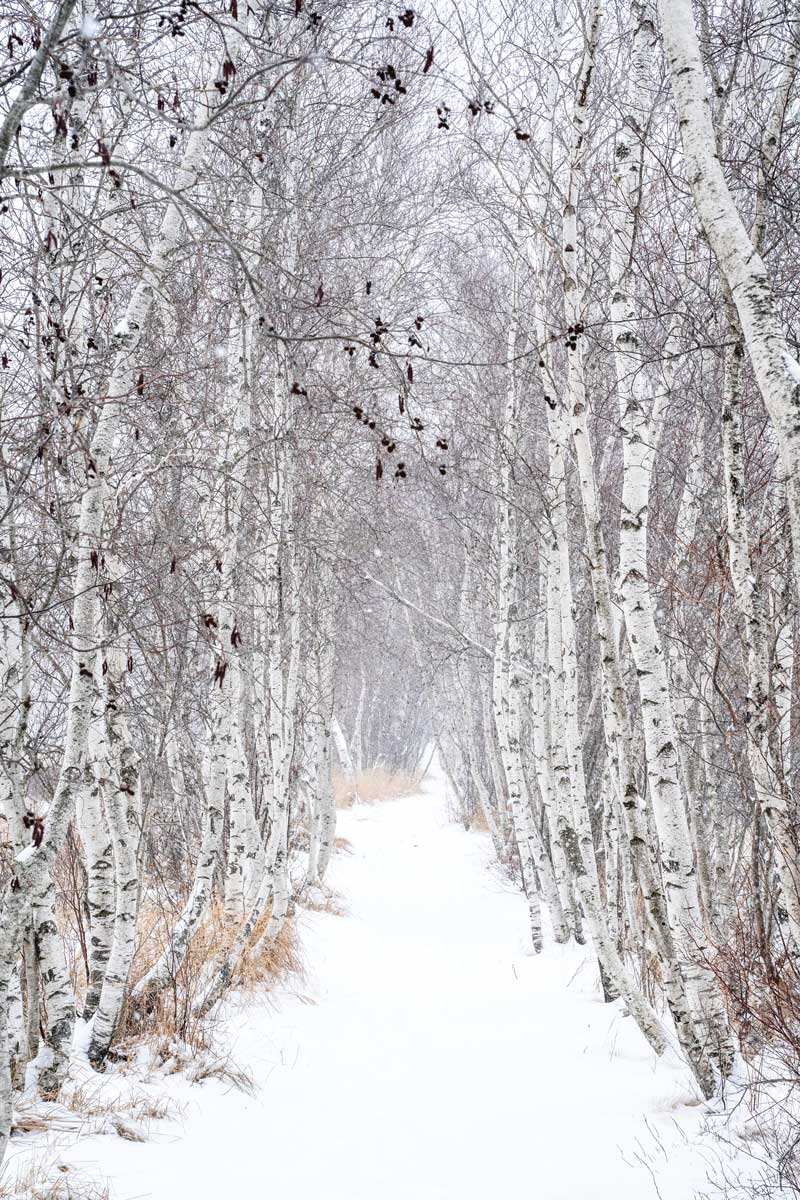
The park’s visitor center, campgrounds, nature center, and lone concessionaire (the Jordan Pond House) are all closed through May. So are the fee-collecting entrance stations, but visitors are nonetheless required to have and display an entrance pass, purchased at recreation.gov, from local chambers of commerce, or from a machine in the Hulls Cove Visitor Center parking lot. A $30 vehicle pass covers seven days of access. Hospitality options around MDI’s gateway towns are much diminished in winter — the Bar Harbor chamber maintains a helpful list of year-round businesses.
Before last year, I never considered myself a “winter person”; in fact, quite the opposite. During my time in Acadia, however, I challenged myself to become more resilient in these colder conditions — and not only did I gain a new appreciation for my ancestral homeland, I fell in love with the season and the quiet beauty that comes with a Maine winter.




